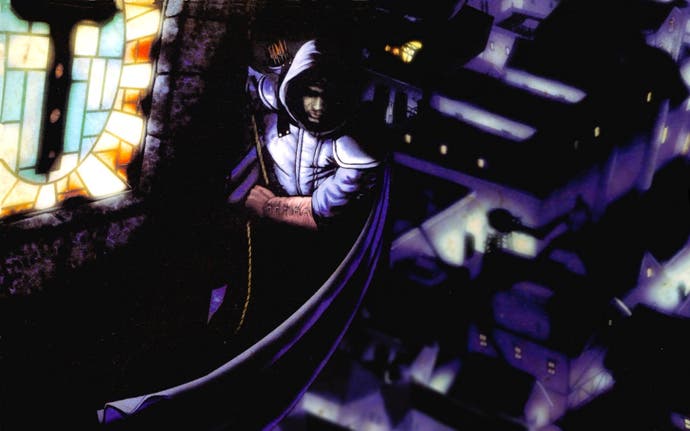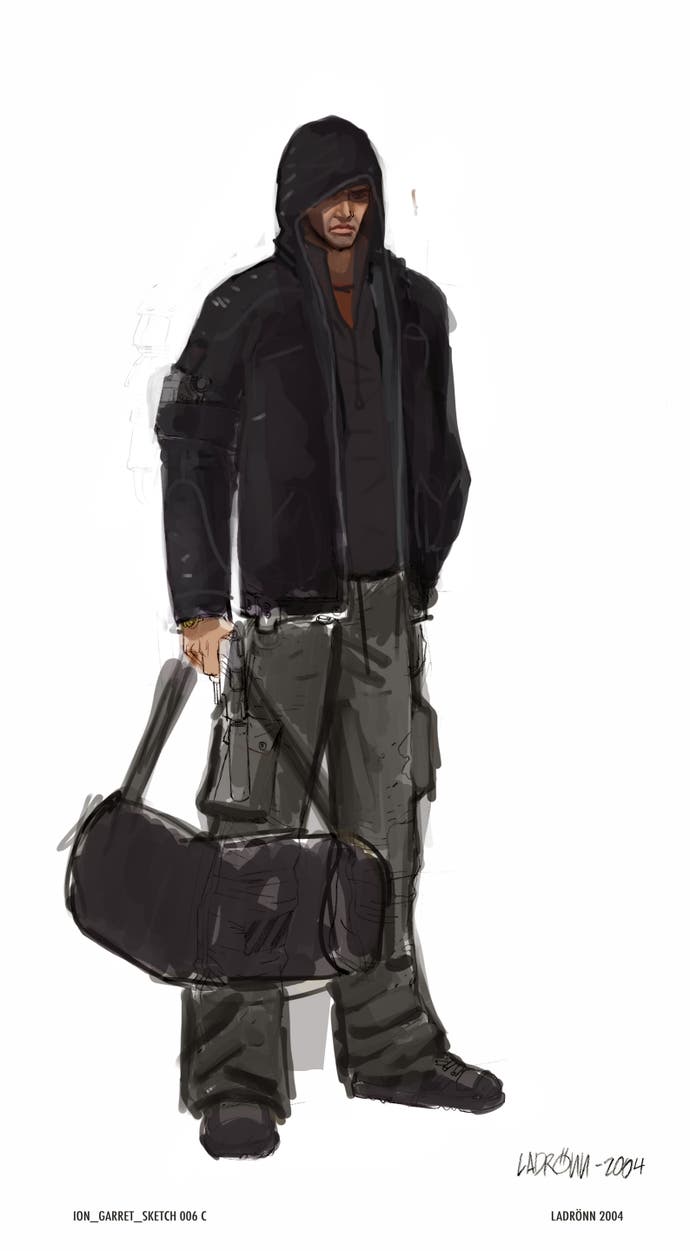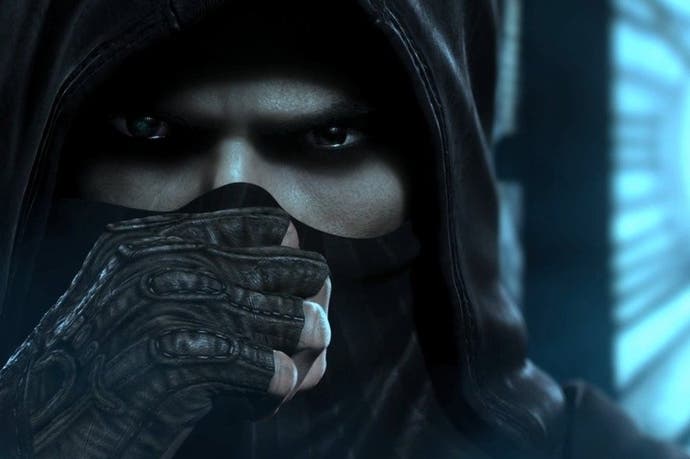The modern day Thief reboot that never was
What's theirs, isn't ours.
Imagine a world where we never had to debate whether Square Enix's 2014 Thief reboot was called Thief or Thief 4 or Thi4f. Imagine instead that the franchise remained with Ion Storm Austin, developers of Thief: Deadly Shadows.
That's a world we very nearly saw, as exclusive research reveals Ion Storm was working on exactly that in 2004 - a never-announced Thief reboot led by Dishonored's Harvey Smith and inspired heavily by Splinter Cell. It was called Thief 4: Dagger of Ways.
Now the bad news - it was cancelled in 2004, along with several similarly unannounced Deus Ex games.
While titled as a sequel however, Thief 4: Dagger of Ways was - like Thi4f - actually a reboot. Hallmarks of the original games, such as Garrett's nameless home city/hunting ground, were to be spun into new and more modern versions of themselves.

"This is not the unrecognisable setting from the earlier Thief games," explains the first page of Ion Storm's internal pitch to Eidos. "This is modern Earth, at night, with some stylised elements - a blend of New York, Los Angeles, Boston and other American cities. Game environments will feature recognisable elements from modern day society...derelict convenience stores and dark back-alleys.
"We want to present a darkly colourful world of shadow, neon and moonlight wherein Garrett will explore rooftops and street corners in one mission and a corrupt senator's mansion in another."
It's easy to imagine this abrupt change to a modern setting as Ion Storm's reaction to pressure from the publisher. Thief's original world (borne out of the also cancelled Dark Camelot project) would have seemed risky to an ailing publisher such as Eidos, especially given the then-recent financial failure of Thief: Deadly Shadows. Surprisingly though, the decision to change up was a joint decision and as personally motivated as corporately mandated.
"There was a big exec team who didn't know games and were driven more by sales and market trends," said a source who worked on the game, and asked to remain unnamed. Eidos, then ailing after a string of high-profile failures, wanted blockbuster hits and mainstream concepts.
"Luckily, we were really excited about the idea of doing a modern Thief. We felt we could modernise while still remaining true. We knew that Eidos didn't like us that much as a studio and didn't 'get' our games, [so] we wanted to push back against the idea that we couldn't produce a high quality, polished game."
This source - who would only speak under condition of anonymity - says the tension between Ion Storm and Eidos was the impetus for several creative compromises on Dagger of Ways. Ion Storm planned to introduce bold new features that would reinvigorate and reenergise the Thief series, but previous failures still loomed in Eidos' memory. Many of the most ambitious concepts were vetoed even before production or prototyping could begin - a process which meant smaller details such as lock-picking minigames were never formally fleshed out.
The largest cut we know of was the eponymous Dagger of Ways itself - a supernatural weapon which would allow Garrett to scout areas in ghost form and even bypass tricky sections completely.

From Ion Storm's pitch: "Initially only an exotic weapon, [The Dagger] reveals other powers which have a direct effect on the game world. The player will be able to use the dagger to shift into a wraith realm, bypassing human guards. This wraith world is filled with shadowy monstrosities...whenever Garrett kills someone, the wraith world gets deadlier as the shadows multiply."
Elaborate scenarios are described in detail, with Garrett able to switch in and out of the wraith world on the fly and choose which environment to move in. The human world may feature occasional bottlenecks that were difficult to traverse undetected, but the wraith world would swap that for a more constant level of threat. By dipping in and out of wraith-form, Garrett could scout areas and fill in the map at speed.
Wraith-like abilities would have been a striking departure from Garrett's traditional toolset of arrows and flash bombs, but they aren't the only change. The overall tone of Thief 4 would have grown darker, more menacing and more industrial too, with Wesley Snipes' first Blade film cited repeatedly as a touchstone. Ion Storm sought to create a similar sense of horror to the film by using the gameplay to maximise discomfort and emotional involvement.
This wasn't just horror for the sake of horror, however. The team believed players would care more about consequences if the ambience was scary enough to provoke disgust. From Ion Storm's pitch: "People on the street seem almost ghoul-like. A wealthy woman partially unclothes and Garrett sees horrible, ritualistic scarring across her back. A serial killer plies his trade in the name of an ancient cult."
Cleverly, Ion Storm's plan didn't rely on grotesquery alone, but also Garrett's inability to combat it. The original Thief games may have created tension by pitting a weak character against physically superior foes, but Dagger of Ways would create it by pitting Garrett against exotic and mystical threats he wasn't sure how to handle.
"Garrett is a criminal in the modern world, relying on night vision and semi-automatic weapons, but he must use these tools against increasingly horrifying and supernatural opponents."
This tension of being mismatched to challenges would have run through Dagger of Ways like a seam. Garrett's technology would be ineffective against supernatural threats; his escapades in the wraith world would be treacherous due to his frailty and his grounded outlook would be challenged by esoteric cults and conspiracies.
Or, that was one plan anyway. Eidos' management vetoed the wraith world and supernatural elements to refocus on a more contemporary mould. Most of what we know about Thief 4: Dagger of Ways now comes from an internal pitch document that's more of a snapshot than a complete picture.

"It's frankly misrepresentative on some topics," said our source. "For example, Eidos told us to cut all of the supernatural stuff, but in [the pitch] the supernatural stuff is still there...We wanted to create scenarios where Garrett might come up to what looked like an impossible challenge in the real world, then slip into the wraith world and see a different challenge that was surmountable."
"When we pitched that to Eidos, the feedback was 'no supernatural stuff'...After a few months we were going with a 100% realistic game set only in the real world. Many designs and decisions changed by the time the project was killed."
Tracking how Thief 4: Dagger of Ways may have looked at the point of cancellation is ultimately a futile and impossible exercise. Secrecy is paramount in the games industry and all other traces are been either locked away or destroyed, along with documentation from other cancelled games. 11 years later and most sources we tracked down wouldn't even confirm the project existed for fear of legal repercussions.
Worse, the sources disagree with each other too. The pitch document may describe Thief 4: Dagger of Ways as a modern stealth game with supernatural elements, but Eidos' internal budgets describe it as a "realistic shooter with tactical, visceral combat". It also pegs Thief 4 with a $6.6 million budget - a small sum to develop what Ion Storm had in mind.
Ultimately, while the pitch document may not offer an accurate impression of Dagger's final moments, it does provide a glimpse of the mostly creative intent - and some tantalising story details too.
"As a child, Garrett's family was part of a scholarly secret society called The Keepers," says the document. "Over time, the organisation became more cultish. His mother and father - refined and educated - disappeared trying to escape. Garrett eventually got away...his younger sister did not."
Dagger of Ways would then begin years later, with Garrett using his training to orchestrate heists. As always he'd come into conflict with various secret societies - but this time not the Hammerites and Pagans. Instead, Thief 4 would introduce The Church and The Openers.
"The Openers [are] seemingly a new power, but with ties to forces older than human society. [They] seek to unleash the dark magic that is awakening in the world. The Church, fading in the modern world, sees conflict over the emerging supernatural world as a chance to make manifest their influence over their believers."
"Eventually, Garrett's sister, now a Keeper agent, confronts him about the truth, giving him a choice to make."
What truth? It's never clarified exactly. The overview promises Garrett would play a deciding role in a "shadow war", but doesn't explain further. Ten years later, memories are so faded even those close to the project are uncertain how it would have played out.
"I honestly remember next to nothing about the story stuff," said our source. "The only specific thing I do I remember is that the first mission was about breaking into Senator Bafford's mansion."
Some flavour text shines a light on this level, but it's a dim outline. A crime lord called Constantine - who, like Bafford, is a mark Garrett targets in the original Thief - would task Garrett with planting a forged letter in Bafford's home. Actions in a previous level could also reveal additional secret objectives - such as to steal evidence Bafford is using to blackmail a local drug dealer.
There are gameplay details too - Garrett's nightvision could be overloaded by enemy flashlights; lockpicking would involve a sound-based mini-game - but it's all unrealised ambition. Thief 4: Dagger of Ways never made the transition from page to pixels and these ideas never even got as far as a prototype.
"We never had anything playable," said our insider. "That was partly because one of our first tasks was doing engine evaluations. The game engine for DX2 was rife with problems, so we spent time deciding what engine we were going to use. We spent the rest of the time on documentation and concept art."
Things proceeded in this vein for six months, but changed when project lead Harvey Smith left to explore new opportunities.
"There was a sense of inevitability when the game was cancelled," said our source. "We knew Deus Ex: Invisible War and Thief: Deadly Shadows hadn't hit Eidos' financial goals. There had been some management changes...the atmosphere was apprehensive. Every time there was a company meeting, we were asking if this was going to be it..."
Whether Smith's departure was the cause or catalyst for the cancellation, the events were clearly linked. Without Smith, Thief 4 couldn't continue and the team was scattered. Smith, who declined to comment for this article, ended up at Midway on the controversial Blacksite: Area 51. After that came Dishonored.
"It is fascinating to revisit Thief 4 with Dishonored in mind," our source reflected. "There's a lot of shared DNA there."
"There are similarities in terms of the action and dark supernatural elements, but the specifics of those similarities are so different. Our plans for Thief 4 were focused on a cool, modern setting with magic and a real sense of horror. Dishonored has magic, but it's pretty pointedly neutral. And once you get to player powers, Thief 4 was about gadgets whereas Dishonored is about personal abilities."
During this time, Eidos - now owned by Square Enix - set to work on a different reboot. The reception for Thi4f was lukewarm at best and a flashy marketing campaign that sought to establish Garrett as a cool anti-hero is visible proof of pressure to modernise the series in pursuit of profit - a pressure Ion Storm also felt.
"It was eye-opening to see how things operated in terms of chasing the market instead of valuing creativity for the sake of making the best game," says our source, looking back. "Eidos' executive team didn't care about games, they only cared about money."
The money never came, obviously - neither for Dagger of Ways nor any other Eidos title. Soon after Ion Storm's collapse the publisher began suffering yearly losses of almost £100 million and was saved only by Square Enix's rapid acquistion. The irony is that, in focusing on the money, Eidos missed the moral which Garrett always learns - that eventually you need to stop thinking about making a quick buck if you want to stay alive.












